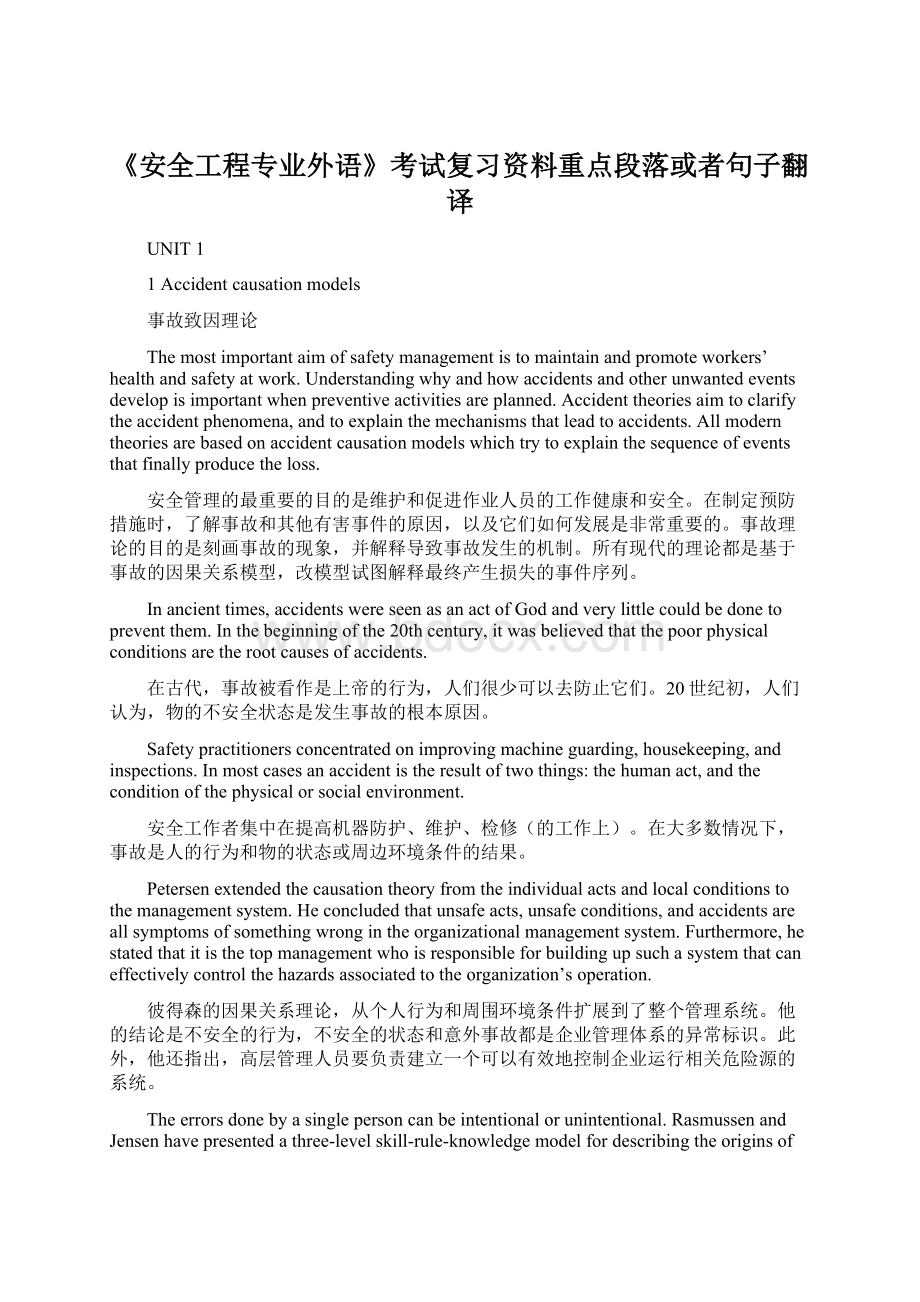《安全工程专业外语》考试复习资料重点段落或者句子翻译Word文档下载推荐.docx
《《安全工程专业外语》考试复习资料重点段落或者句子翻译Word文档下载推荐.docx》由会员分享,可在线阅读,更多相关《《安全工程专业外语》考试复习资料重点段落或者句子翻译Word文档下载推荐.docx(18页珍藏版)》请在冰豆网上搜索。

20世纪初,人们认为,物的不安全状态是发生事故的根本原因。
Safetypractitionersconcentratedonimprovingmachineguarding,housekeeping,andinspections.Inmostcasesanaccidentistheresultoftwothings:
thehumanact,andtheconditionofthephysicalorsocialenvironment.
安全工作者集中在提高机器防护、维护、检修(的工作上)。
在大多数情况下,事故是人的行为和物的状态或周边环境条件的结果。
Petersenextendedthecausationtheoryfromtheindividualactsandlocalconditionstothemanagementsystem.Heconcludedthatunsafeacts,unsafeconditions,andaccidentsareallsymptomsofsomethingwrongintheorganizationalmanagementsystem.Furthermore,hestatedthatitisthetopmanagementwhoisresponsibleforbuildingupsuchasystemthatcaneffectivelycontrolthehazardsassociatedtotheorganization’soperation.
彼得森的因果关系理论,从个人行为和周围环境条件扩展到了整个管理系统。
他的结论是不安全的行为,不安全的状态和意外事故都是企业管理体系的异常标识。
此外,他还指出,高层管理人员要负责建立一个可以有效地控制企业运行相关危险源的系统。
Theerrorsdonebyasinglepersoncanbeintentionalorunintentional.RasmussenandJensenhavepresentedathree-levelskill-rule-knowledgemodelfordescribingtheoriginsofthedifferenttypesofhumanerrors.Nowadays,thismodelisoneofthestandardmethodsintheexaminationofhumanerrorsatwork.
个人错误可能是有意的或无意的。
拉斯穆森和Jensen提出了三个层次的技术规则知识模型,用于描述不同类型的人为错误的起源。
如今,这种模型是工作中的人为错误检查的标准方法之一。
2Safetymanagementasanorganizationalactivity
作为安全活动的安全管理
Safetymanagementisoneofthemanagementactivitiesofacompany.Differentcompanieshavedifferentmanagementpractices,andalsodifferentwaystocontrolhealthandsafetyhazards.Organizationalcultureisamajorcomponentaffectingorganizationalperformanceandbehavior.
安全管理是企业的管理活动之一。
不同的企业有不同的管理办法,以及不同的方式来控制健康和安全隐患。
企业文化是影响企业绩效和行为的一个重要组成部分。
OnecomprehensivedefinitionforanorganizationalculturehasbeenpresentedbyScheinwhohassaidthatorganizationalcultureis“apatternofbasicassumptions–invented,discovered,ordevelopedbyagivengroupasitlearnstocopewithitsproblemsofexternaladaptationandinternalintegration–thathasworkedwellenoughtobeconsideredvalidand,therefore,tobetaughttonewmembersasthecorrectwaytoperceive,think,andfeelinrelationtothoseproblems”.Theconceptofsafetycultureistodayunderintensivestudyinindustrializedcountries.
Schein给出了组织文化的广泛定义,他认为组织文化是由若干基本假设组成的一种模式,这些假设是由某个特定团体在处理外部适应问题与内部整合问题的过程中发明、发现或完善的。
由于以这种模式工作的有效性得到了认可,因此将它作为一种正确的方法传授给新成员,让他们以此来认识、思考和解决问题(指适应外部与整合内部的过程中的问题)。
如今,安全文化的概念是工业化国家的热点话题。
Theseinclude:
organizationalresponsibilityforsafety,managementattitudestowardssafety,managementactivityinrespondingtohealthandsafetyproblems,safetytrainingandpromotion,levelofriskattheworkplace,workers’involvementinsafety,andstatusofthesafetyofficerandthesafetycommittee.
这些措施包括:
企业安全生产责任制,安全管理态度,应对健康和安全问题的管理活动,安全培训和推广,工作场所的风险水平,作业人员的安全参与,安全员和安全委员会。
句子分析:
Allmoderntheoriesarebasedonaccidentcausationmodelswhichtrytoexplainthesequenceofeventsthatfinallyproducetheloss.
Thestrategicmanagement,leadership,motivation,andthepersonnel’svisibleandhiddenvaluesaresomeissuesthatarenowunderintensivestudy.
当今的热点话题是战略管理,领导,激励,人员的可见的和隐藏的价值。
UNIT2
SystemSafety
系统安全
Systemsafetyengineeringdrawsuponsystemsafetyconceptsandtheapproachesusedinsystemengineering.Itsobjectiveistosafelyintegrateallsystemcomponentsinamannerconsistentwithothersystemcriteria.
安全系统工程应用了系统安全的概念和系统工程中的方法。
其目的是以与其他系统标准相一致的方式安全地集合系统成分。
Itinvolvestheapplicationofscientificandmanagementprinciplesforthetimelyrecognition,evaluation,andcontrolofhazards.Throughthelogicalprogrammingoftheseeffortsoverasystem’slifecycle,thedesiredlevelofsafetycanberealized.
它涉及科学的管理原则的应用,以便及时识别,评估和控制危险源。
通过系统生命周期的逻辑编程,可以实现期望的安全水平。
Systemsafetyprogram
Thedegreeofsafetyachievedinasystemdependsontheimportanceitisgivenbysystemdesigners,managers,andoperators.Theeffortsnecessarytoassurethatsufficientemphasisisplacedonsystemsafetyareoftenorganizedintoformalprograms.
在一个系统中能够实现的安全程度取决于系统设计人员,管理人员和操作人员对安全的重视程度。
在正式的规划中,有必要确保充分的强调落实到系统安全中。
Theobjectivesofsuchprogramsaretorecognize,evaluate,andcontrolsystemhazardsasearlyinthelifecycleaspossible.Adequatesafetyinputduringtheinitialphasesisthekeytoproduceaninherentlysafesystem.Effectivesystemsafetyprogramsalsoeliminatethescheduledelaysandcostlychangesthatoftenresultinsystemsthatdidnothaveadequatesafetyplanning.
(系统安全)规划的目的是尽早地在系统生命周期识别、评估和控制系统危险源。
初期阶段,足够的安全投入是建立本质安全系统的关键。
有效的系统安全规划还消除了工期延误,昂贵的变化。
Theheartofasystemsafetyprogramisintheperformanceofhazardanalyses.Theseeffortsalsoinvolvemostofthedetailworkofsystemsafetyengineering.Analysesareconductedtoidentifyandevaluatehazardswithinasystem.Withthisinformation,responsibleofficialsmaydeterminethesafest,mostefficientmeansofcontrollingthehazardsidentified.
系统安全规划的核心是进行危险源分析。
这些还涉及系统安全工程的具体工作。
分析有利于识别和评估系统内的危险源。
有了这些信息,负责人可以确定最安全、最有效控制危险的措施。
Withitsaccidentsourceseliminated,theentiresystemalsobecomesmoreeffectiveinperformingitstask.Ingeneral,hazardanalysesareconductedasfollows:
Gainanunderstandingofthesystem.
Definethescopeandpurposeoftheanalysis.
Selectandapplyananalysistechnique.
Evaluatetheresults.
随着消除事故来源,整个系统也变得更有效地完成其任务。
在一般情况下,危险分析的步骤如下:
理解系统。
定义分析的范围和目的。
选择和应用分析技术。
评估结果。
Hazardanalysisisnotanintuitiveprocess.Forananalysistobemeaningful,itmustbelogical,accurate,descriptiveofthesystem,andbasedonvalidassumptions.Itssuccesslargelydependsontheskillandknowledgeofthoseconductingtheanalysis.Anyonewhohasathorough,workingknowledgeofboththesystemunderconsiderationandtheanalysistechniquetobeusedmayperformahazardanalysis.
危险分析过程不是凭直觉就能完成的。
对于一个有意义的分析,必须在有效的假设基础上对系统进行合理的、准确的描述。
它的成功主要取决于进行分析的人所具有的技能与知识。
只要对被研究的系统和用于分析的技术有全面的了解,任何人都可以进行危险分析。
UNIT3
Aprocessisasystemwherebynecessarycomponentsfunctionandinteracttoproduceadesiredgoal.Similarly,anergonomicsprocessisaplaninwhichafacilitygathersallrelevantinformationonworkorganization,employeecapabilitiesandlimitations,andwork-relatedMSDs,todevelopsolutionstobetteraccommodatetheseemployeesandreduceMSDratesandtheirassociatedcosts.
一个过程是一个系统规定的必要组成部分的功能和相互作用,从而产生一个预期目标。
同样,人体工程学设计的过程是提出更好地满足员工并降低骨骼受伤率及其相关的费用的解决方案,究其而言,其好处是收集所有与工作组织相关的信息、雇员的能力和局限性、以及因工作带来的骨骼损伤。
Oneimportantaspect,actuallytheprocess'
skeypurpose,istocommunicateinformationamongallthoseinvolved,sothatadequateandfeasiblesolutionstoproblemshavingergonomicsissuescanbesolved.Employeeinvolvementintheergonomicsprocess,acrossseverallayersofanorganization,helpstoensureitssuccess.
其中一个重要的方面,实际上也是这个过程的主要目的,是所有有关各方之间的信息沟通,以至于对人体工程学问题有适当的、可行的解决方案。
在人机工程学的过程中,企业各个层次员工的参与有助于确保其成功。
Whenindividualsinacompany,fromtheupperechelonsofmanagementtothehourlyemployee,contributetomakingchangesinworksystemsandjobsites,theybecomeempoweredandmoreresponsibleforthesechanges.Thiscooperationandemployeeinvolvementleadstofeasibleandsuccessfulchangesthatservetoimprovethecompany.Asuccessfulergonomicsprocessneedstobeimplementedandrefinedacrossvarioustypesoforganizations,sothatawidevarietyofwork-relatedissuescanbeincorporated.
当一个公司的个人,从管理高层人员到按小时计的雇员,有助于使工作制度和工作场所的安全改变时,他们对这些变得更有能力和责任。
这种合作和员工参与有利于提高公司的改革切实可行。
一个成功的人体工程学设计过程中需要在各类组织实施和完善,使各种各样的工作有关的问题可以纳入。
Onesuchprocesscomprisesfivefundamentalelements:
TheWorkplace;
TheErgonomicsCommittee;
Management;
MedicalManagement;
TheErgonomicsExpert.
一个这样的过程包括五个基本要素:
工作场所;
人类工效学委员会;
管理;
医疗管理;
人类工效学专家。
TheelementfromwhichbasicergonomicsissuesariseistheWorkplace;
thatis,theareainwhichthephysicalworkisbeingperformedandwhereemployeesbecomeinjuredduetomusculoskeletalstressors.ItistheresponsibilityoftheErgonomicsCommitteetoidentifythesestressorsandprovidesolutions.Theremainingthreecomponents(management,medicalmanagement,ergonomicsexpert)providesupportfortheinteractionbetweentheWorkplaceandtheErgonomicsCommittee.
基本的人体工程学问题产生的因素是工作场所,即是,在身体紧张工作的部位,因肌肉骨骼的压力而受伤。
工效委员会的责任是确定这些压力,并提供解决方案。
其余的三个组成部分为(管理,医疗管理,工效学专家)在工作场所和工效学委员会之间的相互作用提供了支持。
Thecompany'
smanagementCommitteeisresponsibleforcommittingtotheprocessitself;
thatis,emphasizingthevalueitplacesonitsemployees,andforinitiallyprovidingmonetaryandpersonnelresourcestosustaintheCommitteeandthechangesitmakeswithinthefacility.TheMedicalManagementcomponentdealswiththehealthoftheemployees,byprovidingsymptomrecognition,providingpromptandappropriatetreatment,andreturninginjured.
该公司的管理委员会负责提交过程本身,就是强调其关键是雇员,并初步提供货币和人力资源,以维持委员会,并改善内部设施。
医疗管理涉及员工的健康,提供症状的识别,提供及时和适当的治疗,并返回受伤部分。
UNIT4
hazardidentificationisprocesscontrolledbymanagement.